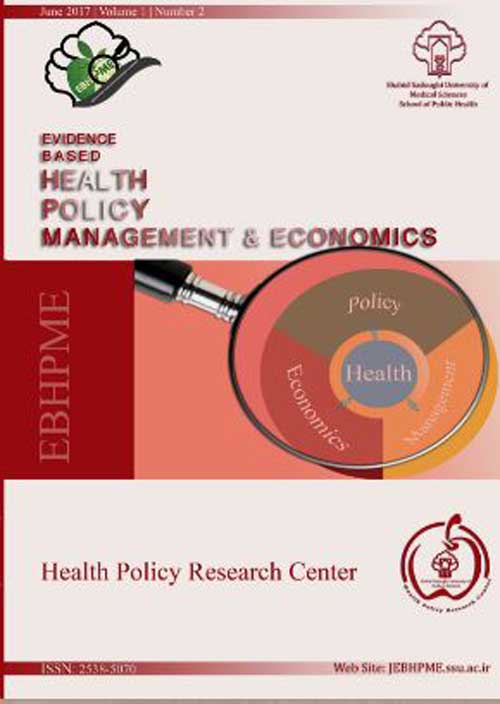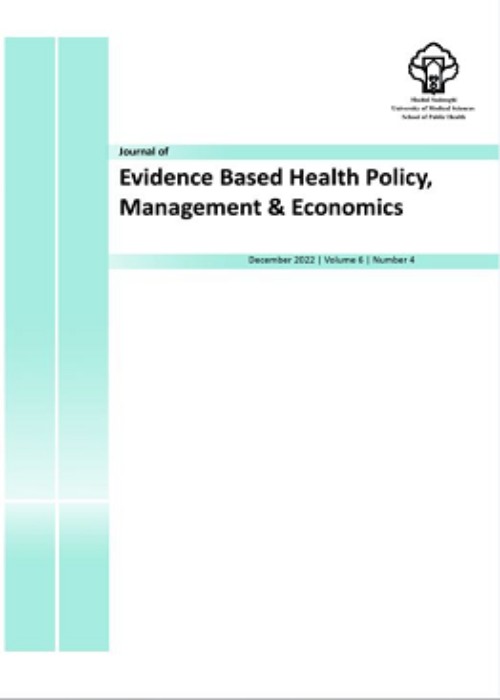فهرست مطالب

Journal of Evidence Based Health Policy, Management and Economics
Volume:5 Issue: 1, Mar 2021
- تاریخ انتشار: 1400/01/21
- تعداد عناوین: 8
-
Pages 4-10
Chronic diseases have become an acute challenge in health. Providing a framework for the transformation of services could be very helpful. In this study, the teamwork services based on lifestyle modification used in a series of Health Clinics in Isfahan (Iran); have been reported as a desirable method in the treatment of metabolic Syndromes. "Iranian Health Clinics" have been providing services in the fields of lifestyle modification, promoting healthy lifestyles, diagnosing and treating metabolic syndromes such as diabetes, hypertension, hyperlipidemia, as well as weight regulation and stabilization. This clinic series offers its services as a team of psychologists, nutritionists, physical trainers, and physicians. Treatment of metabolic syndromes by the team-based method as well as continuing contact with patients in the courses of treatment, stabilization, and training of health ambassadors can be instrumental in consolidating the results using this framework in the control of metabolic syndromes.
Keywords: Health care management, Lifestyle, Behavioral modification, Non-communicable disease, Metabolic syndrome -
Pages 11-18Background
Nowadays, administrative violations are becoming a major problem for health care organizations. Therefore, the present study aimed to determine the type and extent of violations among staff working at a medical sciences university in Iran.
MethodsThis Study was a cross-sectional as well as a descriptive study carried out in 2018. Data were gathered from the administrative violations investigation office of one of the medical sciences universities in Iran. All of the administrative violation records with a final verdict in 2017 were reviewed using the census method. Data entered into the Excel software V.2016, and SPSS16 were analyzed using descriptive statistics.
ResultsThe most frequent reasons for committing the violations were personal and family problems (30 %), the prohibition to work by a spouse (11 %), illness (10 %), and intention to immigrate to another country (8 %). Other causes of administrative violations included heavy work shifts and night shifts; a sense of responsibility towards patients of other doctors; a defect in the doctorchr('39')s timetable registration system; commuting problems; inadequate payment and benefits; lack of familiarity with workplace laws; delay in the payment of fee-for-service in comparison to doctors; and the decision to continue education.
ConclusionOrganizations need to develop an effective mechanism to prevent administrative violations and manage them efficiently. If a mechanism is not competently designed to investigate and identify the deviations and threats to organizational health, it can lead to violation of rights within the organizations.
Keywords: Administrative violations, Human resources, Human resources management, University of Medical Sciences -
Pages 19-28Background
Life skills training is one of the ways to deal with stressful situations and risk-taking behaviors. Given the importance of life skills to deal with risk-taking behaviors such as smoking, the objective of this study was to examine the association between awareness, attitude and life skills and smoking status among boy students in Ilam, Iran.
MethodsThis was a descriptive study that was performed on 553 students in high school boy students in Ilam in 2018. Sampling was conducted in two steps: first, schools were selected by a random sampling method; second, one class was selected randomly from each school and each grade, and all of the students of the selected class were included using the census method. Data were collected through a valid and reliable three-part questionnaire, including demographic characteristics, life skills, and smoking status, and then analyzed by using descriptive and analytical tests at SPSS22 software.
ResultsThe mean age of students, age of smoking initiation as well as the mean of individuals Grade Point Average (GPA) was 13.58, 11.27, and 17.95, respectively. The mean score of awareness toward the harmful effects of smoking, attitude toward smoking, and normative expectations were estimated at 82.18, 32.6, and 68.04, respectively. The total score of life skills was 57.3, which was higher than average. The highest and lowest life skills score was related to problem-solving skills (56.75) and compatibility skills (52.21). Besides, having friends and family members who smoke, attitude toward smoking as well as normative expectations were significantly associated with cigarette smoking status (P-value < 0.05).
ConclusionGiven the results of the study, the life skills score was moderate and far from the ideal status. Therefore, considering the smoking experience at an early age and focusing on life skills training is essential in elementary schools.
Keywords: Life skills, Awareness, Attitudes, Smoking, Students -
Pages 29-42Background
Low productivity and consequently increased health costs can cause various problems in society and the welfare of individuals. The first effect of the high cost of production in the health sector is the collapse of hospitals and health centers into a cost-inflation spiral.
MethodsThis was a descriptive-analytical study. A review section has been revised to describe the concept of productivity through narrative literature review in the descriptive section, using the time series data of 1991-2012 of the Statistics Center of the Islamic Republic of Iran. The micro and macro indicators of health economy and health sector productivity are presented and analyzed graphically with the help of Excel software
ResultsFrom the economic point of view, productivity is defined as the ratio of output to input. The results showed that inflation in the health sector was higher than general inflation in the period under study and that out of pocket expenses were made to cope with inflation in the health sector. On the other hand, the growth rate of production in the entire health sector was decreased, and the number of physicians and bed potency was reduced.
ConclusionThe final result of this study showed that the productivity of the health sector is not in good condition. Despite the increase in the number of beds and doctors in the last two decades, the added-value and production of the entire health sector have not grown significantly.
Keywords: Productivity, Trend analysis, Health sector, Iran -
Pages 43-51Background
The neonatal period or the first 28 days after birth is a critical and vulnerable time for a child period, and the mortality rate is high
due to the severe problems which might happen during this period. The goal of this study was to compare the risk factors associated with the neonatal mortality rate (NMR) before and after the implementation of the health sector evolution plan (HSEP) in Fars Province, Iran.MethodsThis study was a retrospective cross-sectional study. This research was conducted using the census method, and 275951 newborns’ files were studied. Variables are expressed as percentage and frequency. The chi-square test and Fisher tests was used to measure the significance level of variables. A multivariate logistic regression model was also used to estimate the odds ratio of neonatal mortality and risk factors associated with neonatal mortality. All statistical tests were performed bilaterally with P-value < 0.05 considered as significant. All tests were conducted using the software SPSS19.
ResultsAfter HSEP, risk factors of pregnancy and delivery complications were significantly reduced, and abnormalities were significantly increased (P-value < 0.001). Using multivariate logistic regression analysis, the risk of death is nine times more in gestational age below 37 weeks compared to gestational age over 37 weeks. The chances of neonatal mortality among neonates weighing less than 1000 grams are much more, and it is about 140 times more than normal weight (over 2500 grams). There was not a significant relationship between the chance of neonatal mortality and the implementation of HSEP (P-value > 0.05).
ConclusionNeonates with abnormal weight and premature neonates had the highest chance of death. Therefore, the prevention of preterm labor and low-birth-weight infants are essential factors in reducing neonatal mortality. This study suggests that improved health service quality is determinative to decrease neonatal mortality rate.
Keywords: Neonatal mortality, Healthcare reform, Iran -
Pages 52-62Background
People, as the main recipients of healthcare services, consider themselves entitled to the right to choose in the health system. This study aimed to investigate people’s right to choose and freedom about healthcare services from healthcare managers’ perspective.
MethodsThis qualitative study was conducted in 2020. Data were collected through semi-structured interviews with 15 healthcare managers. Then, the snowball sampling method continued until data saturation level was achieved. All interviews were recorded, analyzed, and the main themes were extracted. MAXQDA10 was used for data analysis using content analysis method.
ResultsThe people’s rights to choose their healthcare services were categorized into five main themes: people’s awareness of their right to choose, freedom of choice regarding receiving or not receiving services, government guidelines and policies, choice of hygienic services and medical services in a special way, and barriers to free access to services.
ConclusionRecently, more attention is paid to social values in health systems than in the past, and people have more freedom and choices. On the other hand, to strengthen social justice foundations, there is a need for comprehensive policies and planning in various aspects.
Keywords: Right to choose, Freedom, Health system, Qualitative study -
Pages 63-74Background
This study has been examined in order to examine the studies conducted on disease management in the field of coronavirus caused disease in the type of COVID-19 in the form of area review regarding the development of coronavirus caused disease as a significant challenge in the 21st century and the importance of managing and controlling this disease.
MethodsThis study was conducted in the form of a field review to identify non-clinical and non-laboratory aspects of coronavirus in both Persian and English and the keywords such as "corona", "coronavirus", COVID-19 " were searched in the databases from "Scopus", "Web of Science", "PubMed", "SID" as well as "Google Scholar" search engines since the beginning of 2020.
ResultsThe contents were searched in the adopted databases, and a total of 1257 studies were discovered, and eventually, 18 main papers were extracted and applied after applying the inclusion and exclusion criteria. As the results obtained by the studies explain, a high percentage of the papers focused on stress management, crisis control, and management, focusing on employees and providing the solutions to decrease stress, including exercise, establishing beneficial relationships with relaxation, and so on.
ConclusionIt is better governments provide remote health care services for patients to diagnose and treat this disease due to the speedy spread of coronavirus, lack of definitive treatment, and absence of sufficient quarantine infrastructure for developed patients. Crisis conditions cause all populations engaged in society to share a common purpose and utilize common values in a cooperative movement and progress.
Keywords: Coronavirus, Corona disease, COVID-19 virus


